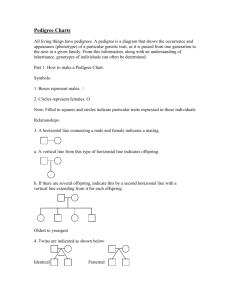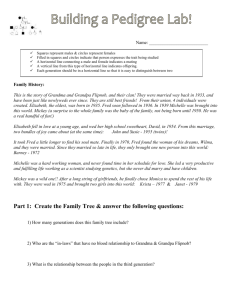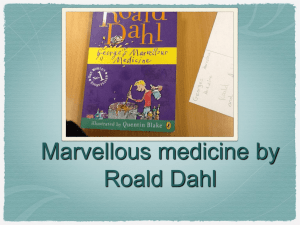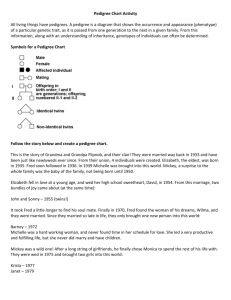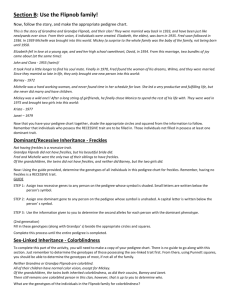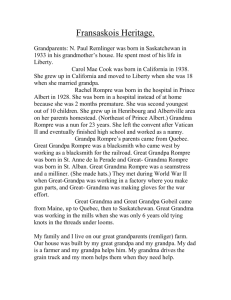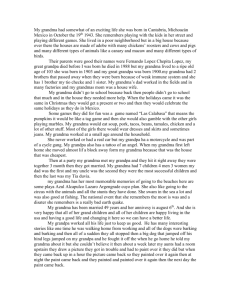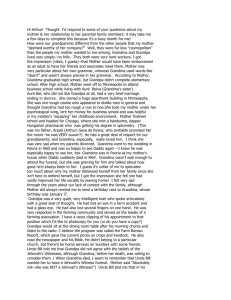Name
advertisement
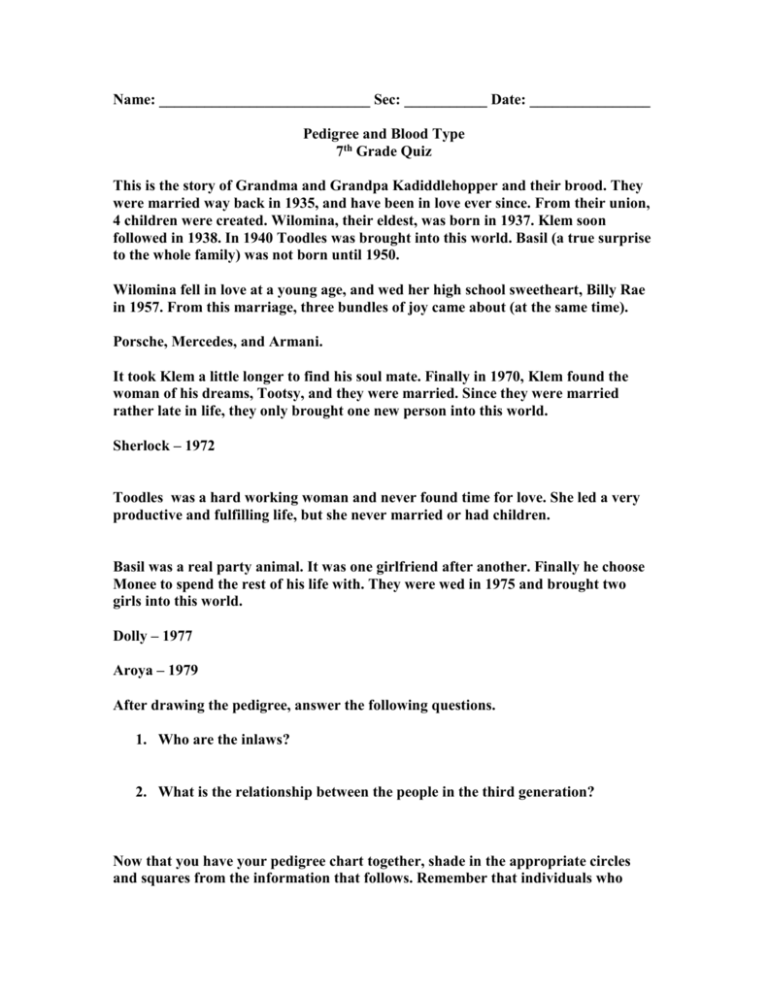
Name: ____________________________ Sec: ___________ Date: ________________ Pedigree and Blood Type 7th Grade Quiz This is the story of Grandma and Grandpa Kadiddlehopper and their brood. They were married way back in 1935, and have been in love ever since. From their union, 4 children were created. Wilomina, their eldest, was born in 1937. Klem soon followed in 1938. In 1940 Toodles was brought into this world. Basil (a true surprise to the whole family) was not born until 1950. Wilomina fell in love at a young age, and wed her high school sweetheart, Billy Rae in 1957. From this marriage, three bundles of joy came about (at the same time). Porsche, Mercedes, and Armani. It took Klem a little longer to find his soul mate. Finally in 1970, Klem found the woman of his dreams, Tootsy, and they were married. Since they were married rather late in life, they only brought one new person into this world. Sherlock – 1972 Toodles was a hard working woman and never found time for love. She led a very productive and fulfilling life, but she never married or had children. Basil was a real party animal. It was one girlfriend after another. Finally he choose Monee to spend the rest of his life with. They were wed in 1975 and brought two girls into this world. Dolly – 1977 Aroya – 1979 After drawing the pedigree, answer the following questions. 1. Who are the inlaws? 2. What is the relationship between the people in the third generation? Now that you have your pedigree chart together, shade in the appropriate circles and squares from the information that follows. Remember that individuals who possess the RECESSIVE trait are to be filled in. Those individuals not filled in possess at least one dominant trait. Dominant/Recessive Inheritance – long fingers Not having long fingers is a recessive trait. Grandpa Kadiddlehopper did not have long fingers, but Grandma did. Wilomina and Klem were the only two siblings to have long fingers. Of the grandchildren, the triplets did not have long fingers and neither did Sherlock, but the two girls, Dolly and Aroya did. Now: Using the guide provided, determine the genotypes of all the individuals in this pedigree chart for long fingers. Remember, not having long fingers is a RECESSIVE trait. GUIDE: 1. Assign two recessive genes to any person on the pedigree whose symbol is shaded. Small letters are written below the person’s symbol. 2. Assign one dominant gene to any person on the pedigree whose symbol is unshaded. A capital letter is written below the person’s smbol. 3. Use the information given to you to determine the second alleles for each person with the dominant phenotype. Example: We know that Grandpa Kadiddlehopper does not have long fingers. If Grandma were BB, could any bb children be produced from Grandma and Grandpa? If Grandma were Bb, could any of the children be produced from them? Use Punnett squares to determine your answer. From your results, what is Grandma’s genotype? ______________________ What must be the genotypes of their children? _________ _________ Fill in these genotypes (along with Grandpa’s) beside the appropriate circles and squares. Sex-Linked Inheritance – Colorblindness Copy your pedigree chart. Remember to determine the genotypes of those possessing the sex-linked traits first. Neither Grandpa nor Grandma Kadiddlehopper are colorblind. All of their children have normal color vision, except for Basil. Of the grandchildren, the triplets inherited colorblindness, as did their cousins, Dolly and Aroya. There still remains one colorblind person in the brood, however, that is up to you to determine who. What are the genotypes of the individuals in the Kadiddlehopper family for colorblindness? Hint: female: xx and male: xy Grandpa and Grandma Kadiddlehopper are really great. Their blood types are A, Rh+ and O Rh+ respectively. The children’s blood types are as follows: Wilomina AO RhKlem OO Rh+ Toodles AO Rh+ Basil AB RhPlease explain the blood types and the Rh factors. What percentage is the Rh-? Is there anything else about the children you need to explain? Prove your theory.
